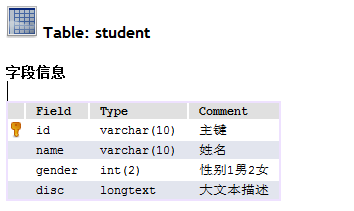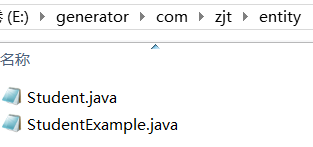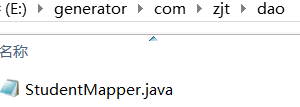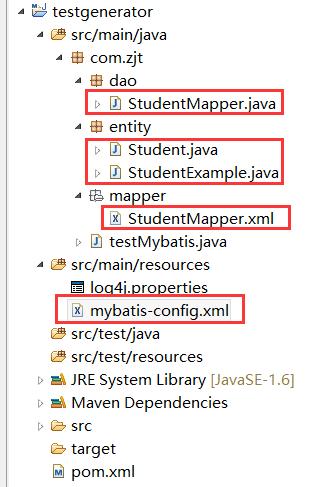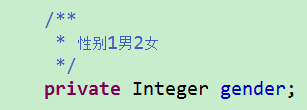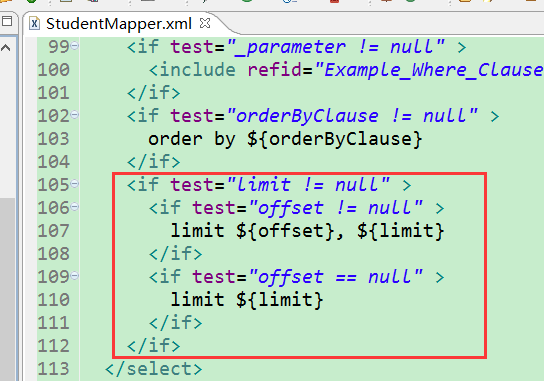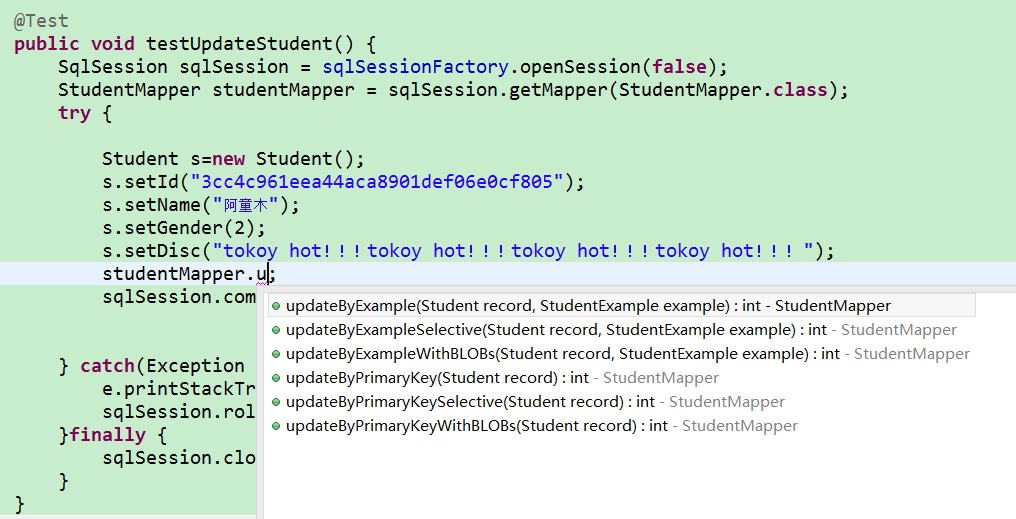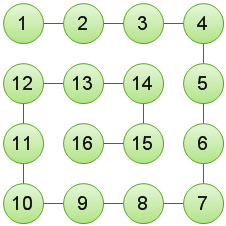引言:
最近的一个项目,由于数据库表巨多,导致需要创建n多个java实体、dao、mapper.xml映射文件,如果均使用纯手工编写,无疑需要耗费大量时间和精力。于是上网学习了mybatis generator的使用。
现在项目写完了,闲暇之余把干货奉上,供大家直接使用。
需求场景:
当你的java 项目数据库有n张表需要使用mybatis进行数据库操作时,建议使用mybatis generator 自动生成工具。可以自动帮助你生成java实体类、dao、mapper.xml等。
首先给大家分享我自己封装好的mybatis generator代码自动生成项目,里面集成了中文注释、mysql的limit分页功能。
git地址:git@github.com:zhaojiatao/com.zjt.mybatisgenerator.git
代码克隆到自己的机器上,import到myeclipse中,需要重新编译一下,就不会报错了。
此外需要注意需要重新引入一下jar文件夹中的mybatis-generator-plugin-1.0.0.jar,如图:
最终目录结构如下:
接下来,请打开配置文件,如图:
(关于generatorconfig.xml的具体教程可参见:http://blog.csdn.net/isea533/article/details/42102297)
接下来,打开generatorconfig.xml,根据你自己的需求,改变如下配置:
首先,修改数据库连接地址。
期次,声明本次需要操作的表及为即将生成的实体类命名。
再次,设置实体文件、dao、mapper.xml生成的路径。
最后,运行startup.java
的main方法执行生成操作。
mysql中本地数据库表为
create table `student` (
`id` varchar(50) not null comment '主键',
`name` varchar(10) default null comment '姓名',
`gender` int(2) default null comment '性别1男2女',
`disc` longtext comment '大文本描述',
primary key (`id`)
) engine=innodb default charset=utf8
对照表,我们看一下生成的包和文件:
其中student.java文件当然就是数据库表实体类,对应表的相关字段。
下面,在我们的项目中导入生成的相关文件,如下:
打开student.java 我们可以发现字段已经生成了中文注释;
打开studentmapper.xml可以发现已经可以使用mysql的limit分页;
在配置好mybatis的数据库连接后(mybatis相关配置请自行baidu,本文终点介绍mybatis generator的使用),我们开始数据库的相关操作:
打开: testmybatis.java
在此,我主要讲几个容易出错的方法和区别:
1.selectbyexample和selectbyexamplewithblobs的区别(包含example的使用)
|
1
2
3
4
5
6
7
8
9
10
11
12
13
14
15
16
17
18
19
20
21
22
23
|
@test
public void testquerystudentexample() {
sqlsession sqlsession = sqlsessionfactory.opensession(false);
studentmapper studentmapper = sqlsession.getmapper(studentmapper.class);
try {
//分页查询性别为男、并且名称中包含z的记录,第一页,每页3条记录,按性别排序
studentexample studentexample=new studentexample();
studentexample.or().andgenderequalto(1).andnamelike("%z%");
studentexample.setoffset(0);
studentexample.setlimit(3);
studentexample.setorderbyclause("gender desc");
list<student> list1 = studentmapper.selectbyexample(studentexample);
list<student> list2 = studentmapper.selectbyexamplewithblobs(studentexample);
system.out.println(list1.get(0).getdisc());
system.out.println(list2.get(0).getdisc());
} catch(exception e){
e.printstacktrace();
sqlsession.rollback();
}finally {
sqlsession.close();
}
}
|
原因:
由于student表中,disc字段类型为longtext,故如果想要搜索结果包含大字段类型,则必须使用selectbyexamplewithblobs。无需检索大字段,则使用selectbyexample;
2.insertselective和insert的区别
当有部分字段未设值时,使用insertselective:
|
1
2
3
4
5
6
7
8
9
10
11
12
13
14
15
16
17
18
19
20
21
22
23
|
<span style="font-size: 14px">@test
public void testinsertstudent() {
sqlsession sqlsession = sqlsessionfactory.opensession(false);
studentmapper studentmapper = sqlsession.getmapper(studentmapper.class);
try {
student s=new student();
s.setid(java.util.uuid.randomuuid().tostring().replaceall("\\\\-", ""));
s.setname("zjt");
s.setgender(1);
s.setdisc("mybatis generator 真心好用");
studentmapper.insertselective(s);
sqlsession.commit();
} catch(exception e){
e.printstacktrace();
sqlsession.rollback();
}finally {
sqlsession.close();
}
}
</span>
|
结果:
当有所有字段均已设值时,使用insert;
|
1
2
3
4
5
6
7
8
9
10
11
12
13
14
15
16
17
18
19
20
21
22
23
|
<span style="font-size: 14px">@test
public void testinsertstudent() {
sqlsession sqlsession = sqlsessionfactory.opensession(false);
studentmapper studentmapper = sqlsession.getmapper(studentmapper.class);
try {
student s=new student();
s.setid(java.util.uuid.randomuuid().tostring().replaceall("\\\\-", ""));
s.setname("zjt");
s.setgender(1);
s.setdisc("mybatis generator 真心好用");
studentmapper.insertselective(s);
sqlsession.commit();
} catch(exception e){
e.printstacktrace();
sqlsession.rollback();
}finally {
sqlsession.close();
}
}
</span>
|
结果:
3.修改操作
updatebyexample
如果example定义了两个字段,数据库共4个字段,则修改数据库的两个字段,其余两个字段改为null;
updatebyexampleselective
如果example定义了两个字段,数据库共4个字段,则修改数据库的两个字段,其余两个字段不动;
updatebyexamplewithblobs
和updatebyexample相比此方法可以修改大字段类型,其余性质和updatebyexample相同
updatebyprimarykey
如果record定义了两个字段,其中有一个字段是主键,数据库共4个字段,则根据主键修改数据库的两个字段,其余两个字段改为null;
updatebyprimarykeyselective
如果record定义了两个字段,其中有一个字段是主键,数据库共4个字段,则根据主键修改数据库的两个字段,其余两个字段不动;
updatebyprimarykeywithblobs
和updatebyprimarykey相比此方法可以修改大字段类型,其余性质和updatebyprimarykey相同
以上这篇mybatis generator 使用方法教程(生成带注释的实体类)就是小编分享给大家的全部内容了,希望能给大家一个参考,也希望大家多多支持快网idc。
原文链接:http://www.cnblogs.com/zhaojiatao/archive/2017/08/17/7380608.html
相关文章
- 64M VPS建站:能否支持高流量网站运行? 2025-06-10
- 64M VPS建站:怎样选择合适的域名和SSL证书? 2025-06-10
- 64M VPS建站:怎样优化以提高网站加载速度? 2025-06-10
- 64M VPS建站:是否适合初学者操作和管理? 2025-06-10
- ASP.NET自助建站系统中的用户注册和登录功能定制方法 2025-06-10
- 2025-07-10 怎样使用阿里云的安全工具进行服务器漏洞扫描和修复?
- 2025-07-10 怎样使用命令行工具优化Linux云服务器的Ping性能?
- 2025-07-10 怎样使用Xshell连接华为云服务器,实现高效远程管理?
- 2025-07-10 怎样利用云服务器D盘搭建稳定、高效的网站托管环境?
- 2025-07-10 怎样使用阿里云的安全组功能来增强服务器防火墙的安全性?
快网idc优惠网
QQ交流群
-
2025-05-27 41
-
2025-05-27 116
-
2025-06-04 43
-
2025-05-27 40
-
Windows计算器怎么算进制程序员模式了解下(电脑计算器算进制)
2025-05-25 80









